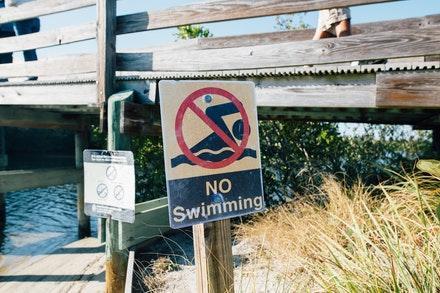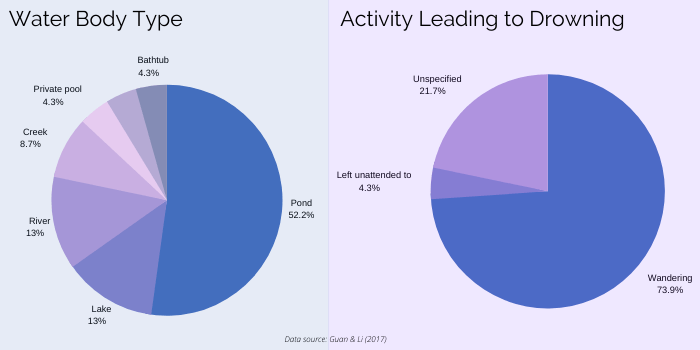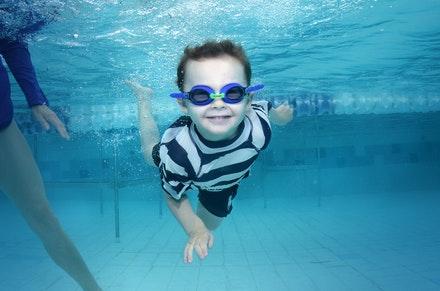Research shows that drowning is the leading cause of death for children worldwide [1], however, children with autism are at increased risk due to several factors which we will outline below.
We will also look at the literature to outline some of the precautions that could be taken, to keep our kids safe around water.
1. Wandering/ Elopement
Children with Autism Spectrum Disorder (ASD) are more susceptible to wandering (also known as elopement) from their parents or care-givers. In addition, they may not perceive risk or danger as readily as their same aged peers.
A study of over 800 parents, showed that approximately 50% of children with ASD between the ages 4–10 wander at some point [2]. This is 4 x more than their typically developing siblings.

With this in mind, the child’s caregiver or swimming instructor needs to pay close attention and provide close supervision in order to prevent wandering. Wandering may include, leaving the group to move to a different area of the pool, leaving the pool to go to the locker room, or leaving the vicinity of the pool all together.
Likewise, a child could wander towards water, away from their caregivers, so extra care needs to be taken around, ponds, rivers, or both fenced and unfenced pools.
According to Grosse (2014):
“As communication skills along with social imagination are often impaired for the individual with ASD, it can be almost impossible to warn such an individual, provide effective precautionary information, and even recall an individual once wandering is initiated.”[3] Thus, prevention is key to minimising the dangers associated with wandering.
2. Water Play Is a Preferred Activity
Water play is a highly preferred activity for a lot of kids with ASD, they find water fascinating and get a lot of enjoyment from it. They may not be aware that bodies of water could be deep and that they can’t just walk over it.
“Water is attractive. It glistens, sparkles, and is engaging to touch. Pleasant experiences in water may reinforce repetitive contact, luring the individual. Perceiving no danger or even unpleasantness, an individual with ASD may not hesitate to engage in dangerous aquatic interactions when wandering”[3].
3. Lack of Awareness around Dangerous Situations
A lack of awareness and lack of understanding around dangerous situations is more common in children with ASD, than their typically developing peers, as is the inability to read or take notice of signs in the community. For example: at the beach they may not take notice of, or read, the danger signs (this is often the case with older children and adults with ASD as well).

4. Lack of Communication Skills
Grosse (2014) states that there are various social communication impairments which may contribute to increased risk for children with autism.
Firstly, a child with ASD may not be able to express themselves, respond correctly or ask questions. This can lead to a lack of understanding around safety as gaining knowledge requires communication.
Secondly, they find it difficult to obtain information and combine it with their past experiences, when compared with their peers who are better able to communicate and socialise.
Finally, they may lack social imagination, which ‘means an individual may not understand consequences of inappropriate behaviour around water.[3]’ This means that they have reduced capacity to predict an outcome following an action, for themselves or those around them.
5. Lack of Services Specialising in Children With ASD
There are limited providers who are specialised in teaching children with ASD, as well as those who teach water safety skills. Standard swim schools may not be effective in teaching water safety to a child with ASD.
A study completed in 2017 [1] found that children who are confident in the water, and have skills such as the ability to submerge, are less likely to drown. They also found that when teaching a child with autism to go underwater, they were only successful when it was part of a behavioural treatment package.
‘During baseline, none of the participants submerged their head underwater despite previous modeling and instruction. Following the implementation of the behavioral treatment package, all three participants submerged their entire head underwater.’[1]
In addition, we can’t solely rely on lessons at the pool as a child may not be able to apply their learning to different locations or scenarios.
According to Guan and Li (2017):
‘These drowning incidents most commonly occurred in ponds (52.2%), followed by rivers (13.0%), and lakes (13.0%)’[2]
This makes it essential that we provide specific learning opportunities across varied bodies of water, so that the child understands what to do and where there might be danger in a number of different situations.
The charts below show the characteristics of unintentional drowning deaths in children with autism spectrum disorder [2].

Celia, Freysteinson, Fredland & Bowyer (2019), found that parents had big concerns for their children’s safety, however there was little information available to support them.
‘Most parents in this sample reported they faced substantial issues with safety for their child. Study results demonstrated that parents received little to no information about safety from healthcare professionals.[6]’
6. Seizures
The prevalence of epilepsy and seizures is higher in those with ASD. As a child with ASD may have difficulty communicating, they may not be aware or make known their symptoms prior to having a seizure. This puts them at extra risk if they are in the water.
Grosse (2014) recommends that autistic children with epilepsy should be supervised to pre-empt a seizure so that they are not in the water or in harm’s way. Although lifeguards may be trained in dealing with seizures, they may not be able to effectively care for the child afterwards due to behavioral issues [3].
Are There Any Precautions We Can Take To Improve Water Safety?
Although accidents can happen, here are 3 things that could help reduce the risk of drowning.
1. Fencing
Following safety advice such as installing fencing around pools and ponds and regularly maintaining those fences. Children with autism may be prone to wandering so making sure appropriate barriers are in place around pools are essential for preventing accidents.

2. Swim Safety
Finding someone who can effectively teach swim safety to the child and help them meet their learning goals is a well-researched method to reduce the risk of drowning.
Guan & Li (2017) state that ‘… parents, pediatricians, and other caretakers should help provide swimming lessons to these children as soon as the diagnosis is made [4]’
In addition to teaching awareness around the dangers of water, these lessons can improve the child’s attention. This could give them the opportunity to call out for help in a difficult situation or find a way to reach safety. Improvements in physical strength and endurance can also help mitigate the risk of drowning.
‘A majority of clinicians reported a substantial increase in swim skills, attention, muscle strength, balance, tolerating touch, initiating/maintaining eye contact, and water safety [5]’
Research shows that teaching skills such as floatation, energy conservation and safety behaviour at an earlier age will help children acquire the skills faster and thus may improve their survival chances in dangerous situations. Parents who undertake water safety training, may help reduce the drowning risk for their children [4] .

The best thing we can do is give our kids the skills, so if they are near a body of water, they know how to keep themselves safe.
Kids with ASD can grow up to be confident, adept swimmers. Regular supervised swimming lessons with a qualified teacher as well as guidance around water safety is key to their successful development.
3. Monitoring Devices
Depending on a risk assessment and proximity to water, Guan & Li (2017) suggest that global positioning system devices may help autistic children who are prone to wandering.
‘In residential environments for children with ASD, it is desirable to have devices that quickly alert parents and guardians when the children elope from the premises. [4]’
In summary, children with autism may be at increased risk of drowning due to numerous factors including an inclination to wander, lack of awareness of danger, communication skills and a fascination with water. Precautions such as installing fences around bodies of water, monitoring and providing children with water safety skills are key to reducing the occurrence of drowning.
Sources
1. Let’s Go Under! Teaching Water Safety Skills Using a Behavioral Treatment Package
2. Autism Plus Wandering
3. Aquatic Safety for Individuals with Autism Spectrum Disorders
4. Characteristics of unintentional drowning deaths in children with autism spectrum disorder
5. Clinicians’ Perceptions of the Benefits of Aquatic Therapy for Young Children with Autism
6. Battle weary/battle ready: A phenomenological study of parents’ lived experiences caring for children with autism and their safety concerns
